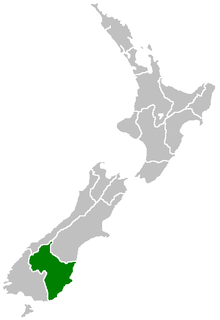Otago
| Otago Regional Council | |
| Country: | New Zealand |
 | |
| Regional Council | |
|---|---|
| Name: | Otago Regional Council |
| Chair: | Stephen Cairns[1] |
| Population: | 198,300 June 2006 estimate[2] |
| Land Area: | 31,241 km² |
| Website: | www.orc.govt.nz |
| Cities and Towns | |
| Cities: | Dunedin |
| Towns: | Queenstown, Alexandra, Cromwell, Oamaru, Palmerston, Wanaka, Frankton, Middlemarch, Lawrence, Balclutha, Brighton, Mosgiel, Milton, Waikouaiti, Moeraki |
| Constituent Territorial Authorities | |
| Names: | Dunedin City Central Otago District Clutha District Queenstown Lakes District Waitaki District |
| Websites: | www.otago.co.nz www.cityofdunedin.com www.qldc.govt.nz |
45°26′S 169°50′E / 45.433°S 169.833°E
Otago () is a region of New Zealand in the south-east of the South Island. It has an area of approximately 32,000 km² (12,350 square miles), making it the country's second-largest region. In the 2006 census, it had a population of 193,800.[3]
The name "Otago" anglicises the Kai Tahu Māori dialect name "Ōtākou". The village of Otakou on the Otago Peninsula served as a whaling base during early years of European economic interest in the east coast of Murihiku around 1840.
Major centres include Dunedin (the Central City of the Region), Oamaru (made famous by Janet Frame), Balclutha, Alexandra, and the major tourist centres Queenstown and Wanaka. Kaitangata in South Otago provides a prominent coal source. The Waitaki and Clutha rivers also provide for much of the country's hydroelectricity-generated electricity.
New Zealand's first university, The University of Otago, was founded in 1869 as the provincial university in Dunedin.
The Central Otago area produces award winning wines made from varieties such as the Pinot Noir, Chardonnay, Sauvignon Blanc, Merlot, and Riesling grapes. Central Otago has an increasing reputation as New Zealand’s leading pinot noir region.[4]
History
The Otago Settlement, sponsored by the Free Church of Scotland, materialised in March 1848 with the arrival of the first two immigrant ships from Greenock on the Firth of Clyde -- the John Wickliffe and the Philip Laing. Captain William Cargill, a veteran of the Peninsular War, served as the colony's first leader: Otago citizens subsequently elected him to the office of Superintendent.
Initial settlement concentrated on port and city, then expanded, notably to the south-west, where the fertile Taieri Plains offered good farmland. The 1860s saw rapid commercial expansion after Gabriel Read discovered gold at Gabriel's Gully near Lawrence, and the Central Otago goldrush ensued. Veterans of goldfields in California and Australia, plus many other fortune-seekers from Europe, North America and China poured into the then Province of Otago, swamping its Scottish Presbyterian character. Further gold discoveries at Clyde and on the Arrow River round Arrowtown led to a boom, and Otago became for a period the cultural and economic centre of New Zealand. New Zealand's first daily newspaper, the Otago Daily Times, originally edited by Julius Vogel, dates from this period.
The Province of Southland separated from Otago Province and set up its own Provincial Council at Invercargill in 1861. After difficulties ensued, Otago re-absorbed it in 1870, but for local government purposes Southland is a separate region.
Provincial government in New Zealand ceased in 1876, and the national limelight gradually shifted northwards. The colony divided itself into counties in 1876, two in Otago being named after the Scottish independence heroes Wallace and Bruce.
Geography

Beginning in the west, the geography of Otago consists of high alpine mountains. The highest peak in Otago is Mount Aspiring, which is on the Main Divide. From the high mountains the rivers discharge into large glacial lakes. In this part of Otago glacial activity - both recent and very old - dominates landscapes, with large 'U' shaped valleys and rivers which have high sediment loads. River flows also vary dramatically, with large flood flows occurring after heavy rain. Lakes Wakatipu, Wanaka and Hawea form the sources of the Clutha, the largest river (by discharge) in New Zealand. The Clutha flows through Otago and discharges near Balclutha.
As you travel east from the mountains, the Central Otago drylands predominate. These are dominated by the block mountains; upthrust schist mountains. Compared to Canterbury, where the Northwest winds blow across the plains without interruption, in Otago the block mountains impede and dilute the effects of the Nor'wester.
The main Central Otago Centres, such as Alexandra and Cromwell, are found in the intermontane basins between the block mountains. The schist bedrock influence extends to the eastern part of Otago where remnant volcanics mark its edge. The remains of the most spectacular of these are the Miocene volcanics centred on Otago Harbour. Elsewhere, basalt outcrops can be found along the coast and at other sites.
Climate
In Central Otago cold frosty winters are succeeded by hot dry summers. Central Otago's climate is the closest approximation to a continental climate anywhere in New Zealand. This climate is part of the reason why Otago is a successful wine-growing region.
References
- ^ "Councillors". ORC website. Retrieved 2007-10-09.
- ^ "Subnational Population Estimates". Statistics New Zealand. 2006-06-30. Retrieved 2007-10-09.
{{cite web}}: Check date values in:|date=(help) - ^ "2006 Census of Population and Dwellings". Statistics New Zealand. 2006-07-03. Retrieved 2007-10-09.
{{cite web}}: Check date values in:|date=(help) - ^ "Central Otago Wine Success At Home And Abroad". 2006-11-11. Retrieved 2007-10-09.
{{cite web}}: Check date values in:|date=(help)
